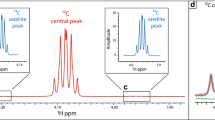Abstract
THERE have been several reports of carbon isotope effects during the decarboxylation of dibasic carboxylic acids such as malonic acid1. Similar effects would be expected in the radical reaction:  The rate at which the radical R.14CO.O dissociates is expected to be less than that for the corresponding reaction of the radical R.12CO.O.
The rate at which the radical R.14CO.O dissociates is expected to be less than that for the corresponding reaction of the radical R.12CO.O.
Similar content being viewed by others
References
Melander, L., Isotope Effects on Reaction Rates, 132 (Ronald Press Co., New York, 1960).
Bevington, J. C., Radical Polymerisation, 41 (Academic Press, London, 1961).
Allen, J. K., and Bevington, J. C., Polymer, 2, 265 (1961).
Author information
Authors and Affiliations
Rights and permissions
About this article
Cite this article
BATES, T., BEVINGTON, J. A Carbon Isotope Effect in the Decarboxylation of the Anisoyloxy Radical. Nature 197, 1294–1295 (1963). https://doi.org/10.1038/1971294a0
Issue Date:
DOI: https://doi.org/10.1038/1971294a0
- Springer Nature Limited





